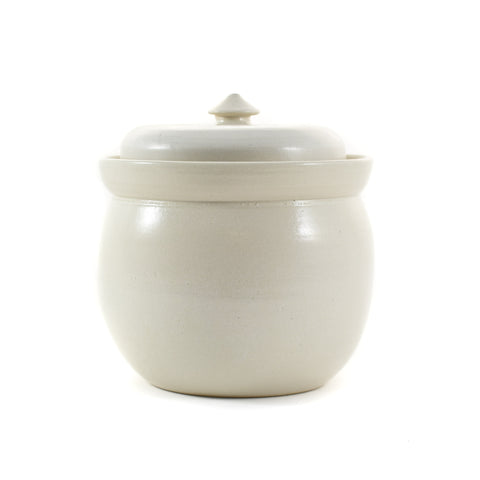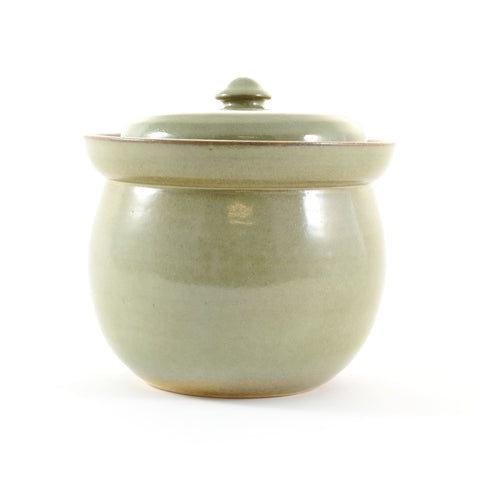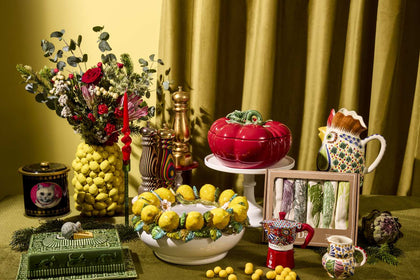The Ultimate Guide To Pickling With Thom Eagle

What is pickling?
As a broad term pickling can include lacto-fermented vegetables as well as brined meat like ox tongue or hams but here I’m focusing on vinegar pickles, which use acetic acid and salt to preserve as well as flavour food – usually vegetables of various kinds, although there are of course (pickled eggs!) exceptions.
Unlike a live ferment, which changes and develops rapidly in time with its colonies of microbes, a vinegar pickle is more or less sterile and static once it has reached maturity, which can take anything from an hour or so to months or more.
In general I find a good rule of thumb is that the more time you are willing to put into a pickle the more you will get out of it; a quick pickled red onion can be put together in minutes and will be ready in a morning, but by the next day it will have lost its crunch and begun to collapse.
A traditionally pickled baby onion or shallot, on the other hand, which takes a day or so in salt brine before a two month immersion in malt vinegar, will, once ready, last more or less indefinitely.
This gives the pickler a great deal of freedom to work within, and it’s entirely up to you which approach you wish to take.
With this handmade stoneware fermenting crock you can make your own sauerkraut, kimchi and pickles at home. With a white glaze, it’s a beautiful piece of kitchen equipment that’s practical, too.
Made in the Netherlands, this stunning crock pot is created by hand, meaning each piece is completely unique. Use your crock for making sauerkraut, kimchi and pickles at home.
How does pickling work?

As a traditional preservation technique, pickling works by creating an environment which is entirely free of microbes, using a strong and salty acidic solution and often (although not always) heat to kill off anything that might be lurking in your jars or vegetables; it’s good practice, especially if you’re making pickles for long storage, to sterilise the jars or pots you’re going to use. To sterilise the jars you should run them through a hot dishwasher cycle, or if you don't have one a good rinse in boiling water followed by drying in a very low oven.
This, as long as you’re using a strong enough pickling solution, should be more than enough to keep you and your pickles safe.
How to ensure everything you make is safe to eat
- To sterilise the jars you should run them through a hot dishwasher cycle, or if you don't have one a good rinse in boiling water followed by drying in a very low oven.
- Be sure to keep at least 2-3% salt to liquid (20-30g a litre) and not diluting the vinegar by more than the suggested amount.
What vinegar can you use for pickling?

You can use more or less any vinegar for pickling. Traditional British pickles were usually made with pure malt or spirit vinegar, with wine and cider vinegars common across Europe; a practical choice when our pickles were really designed to make the summer harvest last through the winter and beyond, but any of these used neat might seem a little harsh to the modern palate.
If you’re only making a jar or so at a time, and if you can once it is open keep each jar in the fridge, then you can allow for taste as well as strength and length of preservation to guide your decisions.
The only thing I would really steer clear of for most pickling is raw apple cider vinegar. Any health benefits the live cultures might have are lost when boiling the liquor, and the pickle will often begin to fizz and ferment (even after boiling), making the vegetables soften and collapse; it also tends to be rather expensive. In any case, follow a few recipes and you’ll soon discover what suits your palate.
My go-to pickling liquor uses white wine or cider vinegar diluted with water – 250ml of water to 750ml of vinegar – with around 30g of sea salt and 100g of sugar to each litre. This is strong enough to work quite quickly, but not so strong as to be wince-inducing – a happy balance, I think.
What texture should a pickle have?
With the vinegar keeping everything safe for you and the pickling liquor at the strength of your liking, the main consideration for your pickles is texture. A pickle to my mind should crunch, a pleasing and refreshing crunch. It shouldn’t be hard or woody and it certainly shouldn’t be slimy. Although you can pickle more or less any vegetable it is good to bear crunch in mind when you are choosing them, and especially when you are deciding what to do with them.
Crunchy vegetables
Young turnips, cauliflower florets, chunks of red or white cabbage all have a pretty much perfect texture as they are, which hold well in a pickle. I usually, as in my spiced cauliflower recipe, speed the process along by pouring the brine over the vegetables straight off the boil.
Cooked vegetables
Alternatively, you could cook the prepared vegetables briefly, directly in the pickling liquor – I often do this with carrots, which otherwise take surprisingly long to pickle in vinegar or a ferment.
Pickles made like this are more or less ready to eat as soon as the brine has cooled, although they are better after a day or two. This doesn’t as you might expect seem to soften the vegetables too much, instead locking the texture in as if they had been very lightly blanched.
Softer vegetables
Softer vegetables need only a little more attention. If you put slices of cucumber or courgette straight into a pickling solution you’d soon find the vinegar diluted by water leaking out of the vegetables as they begin to collapse. Instead, as for a classic bread-and-butter pickle, toss thin slices of cucumber and perhaps some onion with a good pinch of coarse salt and leave to drain in a colander for a few hours or overnight before packing into jars and covering with the pickling liquor.
Although the flesh of the cucumber will seem to have deflated somewhat and the skin turned a dull green the softly giving crunch they have will stay as it is in the pickle for weeks or more.
For a similar effect with vegetables you want to keep whole or in larger pieces, just make up a salt brine of 3-5% (30-50g of salt to 1 litre of water) and immerse them in it for a day or so; this works particularly well with green vegetables like runner beans and asparagus, where you want them slightly softer than raw, and really helps preserve their fresh flavour.

What do I need to start pickling?
All you need to get started pickling is a jar or a pot and of course your ingredients. You can make a jar of just one thing like shallots or chillies but I often like to make mixed pickles, the flavours jumbling up together and softening each other’s edges.
- Take half a cabbage, say, an onion, a couple of baby turnips or radishes, prepare them and wash them and cut them into pieces roughly equal in size, and pack them into your sterilised pot or jar.
- Make up a pickling liquor – as a general rule a one litre jar will hold around 500g of vegetables and need around 500ml to cover them – with whatever spices you fancy, bring it to the boil and pour it over the top!
- Seal the jar and leave overnight to cool down. They’ll be ready to eat the next day, but keep tasting and you’ll find the perfect point.





